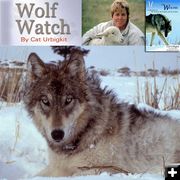Feds explain wolf death
by Cat Urbigkit, Pinedale Online!
May 26, 2009
The U.S. Fish and Wildlife Service issued the following statement about the wolf recently killed in Yellowstone National Park. The wolf had repeatedly chased people.
"A wolf that had become habituated to people and chased bicyclists on more than one occasion was euthanized Tuesday morning by Yellowstone National Park staff along Fountain Flat Drive. The yearling male wolf from the Gibbon Meadow Pack was first sighted in the vicinity of Midway Geyser Basin in March 2009. In recent weeks, the wolf had been frequently observed in Biscuit Basin and the Old Faithful developed areas in close proximity to park visitors. The wolf had reportedly exhibited behaviors consistent with being conditioned to human food.
"The park reports there have been several incidents of unnatural behavior, including chasing bicyclists on at least three occasions, and one report involving a motorcyclist. The park has also received reports of the wolf approaching people, as well as cars, which can best be described as panhandling--behavior consistent with a food conditioned animal. The wolf's repeat offenses clearly demonstrate a habituation to humans and human food, escalating the concern for human safety, according to the park.
"Yellowstone staff made attempts at hazing the wolf from the area, only to have the wolf return and repeat this behavior. Hazing techniques are meant to negatively condition an animal and may include cracker shells, bean bag rounds or rubber bullets; all non-injurious deterrents.
"The decision to remove the wolf from Yellowstone was made in consultation with the United States Fish & Wildlife Service. This is the first time such a management action has occurred since wolves were reintroduced in Yellowstone in 1995-1996. Yellowstone National Park removed this wolf from the population in accordance with the park's habituated wolf management plan.
"This wolf was clearly not behaving naturally, reducing our management options. Human safety is important, so the difficult decision to remove the animal was made. Approaching wildlife, such as wolves, too closely can have detrimental results. We encourage visitors to keep their distance from wildlife and to not feed them," wolf project leader Doug Smith said.
"The park warns of conditioning of wildlife, in particular bears and wolves, to groceries, garbage or intentional feeding. This usually results in habituation, making them a potential danger to people and consequently may result in their destruction. Additionally, people who approach within 100 yards of bears and wolves, and 25 yards of other wildlife, put themselves at risk of injury and increase the potential for habituation of these animals, the part warns. Visitors are reminded to keep food, garbage, barbecue grills, and other attractants stored inside or otherwise unavailable to wildlife.
"The removal of this wolf is not considered to have a detrimental impact to the overall health and population of wild, free roaming wolves in Yellowstone. The wolf population in Yellowstone National Park is currently estimated at 124 animals in 12 packs. Pups that were born this year have not been counted and are not part of this estimate."
|
